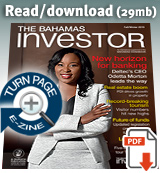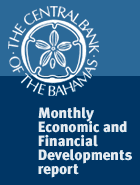| Source: Date: Updated: |
TheBahamasInvestor.com
Tuesday, August 7, 2012 Tuesday, August 7, 2012 |
Preliminary indications are that the domestic economy maintained a mild growth momentum during the review month, supported by gains in tourism sector output, alongside ongoing public sector and foreign investment-led construction activity. Inflation remained modestly above the prior year’s level, although the recent declines in global oil prices softened domestic fuel costs in June. In the fiscal sector, the overall deficit deteriorated over the ten months to April, as higher expenditures outpaced an increase in revenues. Monetary developments featured a modest expansion in bank liquidity, which remained at record levels, and a slight uptick in external reserves.
Initial reports suggest steady improvement in tourism output in June, sustained by growth in the high value-added group segment of the market, increased airlift from several destinations in the eastern United States and Latin America, and ongoing public/private sector incentive programmes. Preliminary information from a sample of hotels in Nassau and Paradise Island showed room revenues firming in June, by 8.3%, as the 9.0 percentage point advance in occupancy rates to 77.7% compensated for the 3.8% contraction in average daily room rates (ADRs) to $228.04. Similar trends were noted over the half year, as gains in occupancy rates, by 6.1 percentage points, to 73.3%, countered declines in ADRs, by 2.5%, to $245.96, to secure a 7.0% hike in room receipts. In comparison with 2008, current occupancy rates are trending above their pre-recession levels; however, increased competition from other destinations, alongside the sluggish growth trends in key markets, has lowered ADRs, to negatively impact overall earnings.
Domestic inflation firmed by 1.2 percentage points, to 3.1%, over the twelve-months to May 2012. This outturn, reflected significant growth in transportation costs, which firmed by 7.0% compared to a 5.2% advance a year-earlier. More modest inflation rates were recorded for furnishing, household equipment & maintenance, housing and related expenses—the largest component of the Index—and restaurant & hotels, of 3.8%, 3.3% and 3.1%, respectively, while most of the remaining categories recorded price gains of under 3.0%.
Reflective of the recent modest decline in international crude oil prices, average domestic energy costs contracted in June. Specifically, the price of both gasoline and diesel fell, by 4.7% and 2.8%, on a monthly basis, to $5.52 and $5.24 per gallon, but grew marginally by 0.5% and 4.0% year-on-year, respectively. Similarly, the Bahamas Electricity Corporation’s fuel charge decreased by 2.9% to 26.97¢ per kilowatt hour (kWh) in June, although exceeding the previous year by 18.5%.
The overall fiscal deficit for the ten months to April widened by $55.6 million (27.0%), in comparison to the corresponding period of FY2010/11, as total outlays firmed by $110.0 million (8.1%) to $1,463.8 million, outpacing a $54.4 million (4.7%) gain in revenues to $1,202.3 million. Tax collections grew by $17.0 million (1.6%) to $1,062.9 million, reflecting mainly an increase in international trade taxes, by $114.0 million (23.6%), as the receipt of arrears payments by a public corporation led to a 71.0% surge in excise taxes. Similarly, a timing-related advance in license fees contributed to growth in business & professional fees, by $4.7 million (5.2%). In a modest offset, other “miscellaneous” tax collections fell by $89.5 million (20.7%) to $343.0 million, following the prior period’s extraordinary boost of stamp taxes, related to the sale of a local oil company. In contrast, non-tax receipts improved by 36.8% ($37.5 million) to $139.4 million, supported primarily by one-off capital revenues related to an asset sale. On the spending side, current outlays rose by $40.3 million (3.5%), led by a $46.8 million (20.3%) hike in purchases of goods and services and a more muted $13.6 million (3.0%) increase in wages & salaries. In contrast, transfer payments fell by $20.1 million (4.2%), due to contractions in both interest payments and subsidies by 8.1% and 2.1%, respectively. Capital outlays firmed by $22.0 million (15.5%) to $163.9 million, owing mainly to a $14.8 million (12.8%) rise in infrastructure spending and a $6.9 million (29.7%) increase in asset acquisitions. In addition, increased assistance to public corporations led to a doubling in net lending, to $89.6 million.
Download The Central Bank of the Bahamas’ Monthly Economic and Financial Developments report here.











